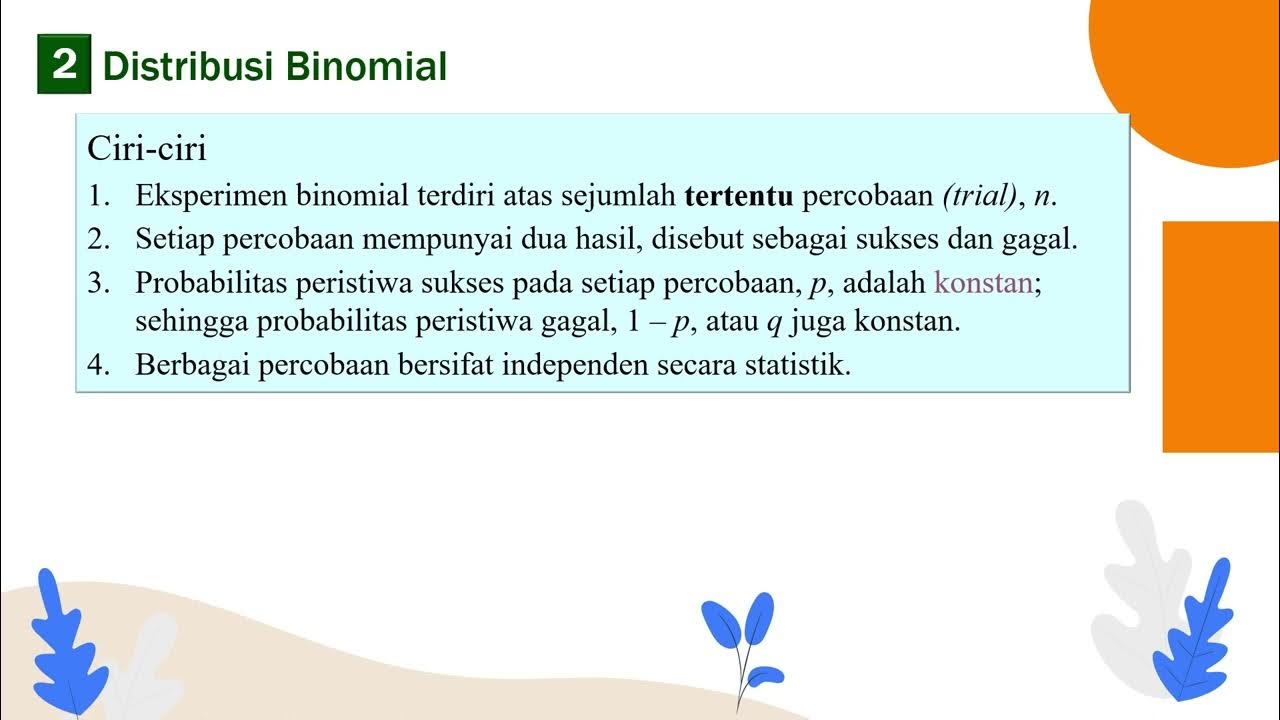[Statistika]: Macam-Macam Distribusi Probabilitas (Binomial, Poisson, Normal dan Student-T)
Summary
TLDRIn this lesson on probability distributions, the lecturer covers key concepts such as discrete and continuous probability distributions, focusing on binomial, Poisson, normal, and Student's t-distributions. The lecture explores real-world applications through examples like a cement factory survey and student smoking statistics. Key topics include Bernoulli trials, random variables, and calculating probabilities using specific formulas. The session provides a thorough understanding of how to apply these distributions to solve problems and introduces the foundational concepts for further studies in statistics, such as hypothesis testing.
Takeaways
- 😀 The lesson covers the basics of probability and introduces different types of probability distributions: discrete and continuous.
- 😀 A binomial distribution is based on Bernoulli trials, where each trial has two possible outcomes: success or failure.
- 😀 In a binomial distribution, the probability of success is denoted by 'P' and failure by '1 - P'. Trials are independent with constant probabilities.
- 😀 An example of binomial distribution is the survey of a cement factory product's popularity in four projects, where probabilities for different outcomes are calculated.
- 😀 The Poisson distribution is used for rare events occurring over a fixed period of time or interval, often as an approximation of the binomial distribution under certain conditions.
- 😀 When using the Poisson distribution, it's crucial that the probability of success (P) is small and the number of trials (n) is large.
- 😀 An example of the Poisson distribution involves the likelihood of a specific number of workers failing to show up for work based on a known probability of absence.
- 😀 A normal distribution is a continuous probability distribution that forms a bell curve, where the highest point is the mean (μ), and the total area under the curve equals 1.
- 😀 For a standard normal distribution, the Z-score (Z) is used to standardize values, where Z = (X - μ) / σ, with X being the value, μ the mean, and σ the standard deviation.
- 😀 The Student's t-distribution is similar to the normal distribution but is used when dealing with small sample sizes (n < 30), and it has wider tails to account for more variability in estimates.
- 😀 Understanding the differences between discrete (binomial, Poisson) and continuous (normal, t-distribution) probability distributions is essential for applying the correct method in different statistical problems.
Q & A
What is the focus of today's class in the transcript?
-Today's class focuses on understanding probability distributions, specifically discrete and continuous probability distributions. The lesson covers binomial distribution, Poisson distribution, normal distribution, and Student's t-distribution.
What are the two types of probability distributions mentioned?
-The two types of probability distributions mentioned are discrete probability distributions and continuous probability distributions.
What is a Bernoulli trial, and how is it related to binomial distribution?
-A Bernoulli trial is a random experiment with two possible outcomes, success or failure. The binomial distribution is based on repeated Bernoulli trials, where the outcomes are independent, and the probability of success remains constant.
How is the binomial distribution calculated in the provided example?
-In the example, the binomial distribution is used to calculate the probability of certain outcomes for a cement company's new product. It involves using the binomial probability formula to determine the chances of a specific number of successes in a series of trials.
What is the difference between binomial and Poisson distributions?
-The binomial distribution is used for a fixed number of trials with two possible outcomes and a constant probability of success. In contrast, the Poisson distribution is used for counting the number of events occurring within a fixed time or space, where the probability of an event is small and the number of trials is large.
Under what conditions can the Poisson distribution be used?
-The Poisson distribution can be used when the number of trials is large, the probability of success is small (less than 0.05), and the expected number of successes remains constant.
How is the normal distribution described in the transcript?
-The normal distribution is described as a continuous probability distribution with a bell-shaped curve. The curve reaches its maximum at the mean (μ) and is symmetrical. It is defined by its mean and standard deviation, with the total area under the curve equal to 1.
What is the standard normal distribution, and how is it related to the normal distribution?
-The standard normal distribution is a special case of the normal distribution where the mean is 0 and the standard deviation is 1. It is used to transform any normal distribution into a standard normal distribution using the formula z = (x - μ) / σ.
How do you calculate probabilities using the normal distribution table?
-To calculate probabilities using the normal distribution table, you first convert the raw score (x) to a standard score (z) using the formula z = (x - μ) / σ. Then, use the z-value to find the corresponding probability in the standard normal table.
What is the relationship between the binomial distribution and the normal distribution?
-The binomial distribution can be approximated by the normal distribution when the sample size is large, and the probability of success is small. This is known as the normal approximation to the binomial distribution.
Outlines

This section is available to paid users only. Please upgrade to access this part.
Upgrade NowMindmap

This section is available to paid users only. Please upgrade to access this part.
Upgrade NowKeywords

This section is available to paid users only. Please upgrade to access this part.
Upgrade NowHighlights

This section is available to paid users only. Please upgrade to access this part.
Upgrade NowTranscripts

This section is available to paid users only. Please upgrade to access this part.
Upgrade NowBrowse More Related Video
5.0 / 5 (0 votes)





